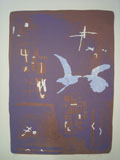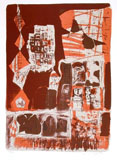Kazu WAKITA |
Born 1908 in Tokyo, Wakita attended Aoyama Gakuin Middle School but had to leave when he followed the family of his elder sister to study in Germany. In 1925, he enrolled at Berlin Staatliche Hochschule für Bildende Künste (School of Fine Arts), specializing in copperplate, lithographs and woodblock prints. He graduated with honors in 1930. Following the death of his father, Wakita returned to Japan, taking care of his late father’s affairs for some time. In 1932, he joined Taihei Painting Academy. Though his submission to the Teiten exhibition of 1935 was unsuccessful, Wakita was included in the Exhibition of Rejects where he received the Showa Prize for Western-style Painting. |
In 1936, Wakita participated alongside fellow artists Gen’ichiro Marugame, Ryohei Koiso, Toshio Nakanishi and Iwao Uchida in the formation of the Shin-Seisaku Print Association (now: Shin-Seisaku Association). As a reaction to a rising climate of militarism and approaching war, he began to focus on subject matters including mothers and children. In 1953, while in treatment for pleurisy, Wakita received a pet bird which caused him to start painting birds. In 1956, Wakita was honored with the Guggenheim International Award. In 1991, the Kazu Wakita Museum opened in Karuizawa (Nagano Prefecture). Wakita was named a Person of Cultural Merit in 1998. He died in 2005 at the age of 97. |
|
|
||||
 "Birds Facing Each Other" 1974 Lithograph Ed. 50 49.0×36.0cm Signed |
 "People Living in the Neighborhood" 1974 Lithograph Ed. 50 50.0×35.2cm Signed |
|||
|
|
||||
Inquiry form |
